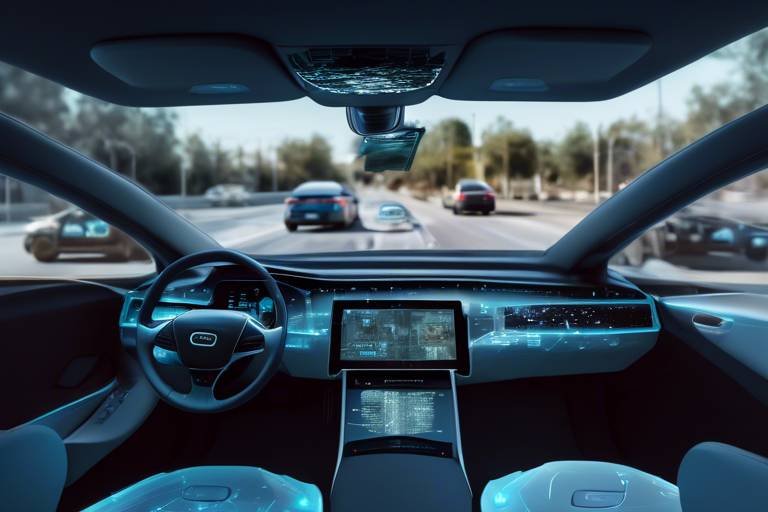AI Innovations in Self-Driving Cars: A Future Perspective
The world of transportation is undergoing a seismic shift, and at the heart of this transformation lies artificial intelligence (AI). Self-driving cars, once a figment of science fiction, are now becoming a tangible reality. With the rapid advancements in AI technology, these autonomous vehicles promise not only to revolutionize how we commute but also to reshape our cities and lifestyles. Imagine a world where you can relax in your car while it navigates through traffic, or where the streets are safer due to the elimination of human error. Sounds like a dream, right? Well, this dream is quickly approaching reality, and in this article, we will dive deep into the innovations that AI brings to self-driving cars, the implications for safety, the regulatory hurdles, and what the future holds.
Recent breakthroughs in AI technology are reshaping the self-driving car industry, enabling vehicles to perceive their environment, make decisions, and learn from experiences, thus enhancing overall driving efficiency and safety. A key component of this advancement is the development of sophisticated sensors and algorithms that allow vehicles to interpret their surroundings. These cars utilize a combination of LIDAR, radar, and cameras to build a comprehensive understanding of their environment. By processing this data through advanced machine learning models, self-driving cars can identify obstacles, recognize traffic signals, and predict the behavior of pedestrians and other vehicles.
As exciting as self-driving cars are, the integration of AI raises crucial safety concerns. How do we ensure that these vehicles are safer than their human-driven counterparts? This is where advanced algorithms come into play. AI systems are designed to minimize risks and improve passenger safety through real-time data analysis. For instance, when a self-driving car encounters an unexpected obstacle, its AI can quickly assess the situation and decide the safest course of action. This capability is critical, especially in dynamic driving environments where conditions can change in an instant.
Machine learning algorithms play a pivotal role in self-driving technology. These algorithms enable vehicles to adapt and improve their performance based on accumulated data and experiences. By continuously learning from their surroundings, self-driving cars can refine their decision-making processes over time. For example, if a car frequently encounters a particular traffic pattern, it can adjust its driving strategy to optimize for that scenario. This adaptability is akin to how we learn from our experiences—making mistakes, learning from them, and becoming better drivers in the process.
Data collection is essential for training AI systems in self-driving cars. The types of data collected include sensor readings, GPS information, and traffic patterns. This data is then analyzed using complex algorithms that help the vehicle understand and predict its environment. The more data a self-driving car collects, the better it becomes at navigating various driving conditions. In fact, some companies are already collecting millions of miles worth of driving data to enhance their AI systems.
Real-time decision-making is critical for self-driving vehicles. In a matter of milliseconds, an AI system must process information from multiple sources, including sensor data and environmental cues, to make split-second decisions. This capability is essential for ensuring the safety of passengers and pedestrians alike. For instance, if a child suddenly runs into the street, a self-driving car must quickly analyze the situation and determine whether to brake, swerve, or take another action to avoid a collision. The speed and accuracy of these decisions can mean the difference between life and death.
Despite advancements, several challenges hinder the widespread adoption of self-driving cars. Technological hurdles such as sensor limitations and software reliability must be addressed. Additionally, ethical dilemmas arise regarding the programming of AI systems to prioritize safety and human life. How should a self-driving car react in a situation where harm is unavoidable? These challenges must be navigated carefully to ensure a successful transition to autonomous vehicles.
The regulatory environment surrounding self-driving cars is complex and evolving. Governments worldwide are grappling with how to regulate this new technology while ensuring public safety. Current regulations vary significantly from one country to another, which can complicate the development and deployment of autonomous vehicles. As the technology matures, we can expect to see more standardized regulations that will help streamline the approval process for self-driving cars.
Different countries approach self-driving car regulations uniquely. For instance, while the United States has been relatively open to testing autonomous vehicles, countries like Germany have implemented stricter guidelines. This global disparity can create challenges for manufacturers looking to deploy their technology internationally. A comparative analysis of various regulatory frameworks reveals the need for a more cohesive approach to facilitate the growth of this industry.
Ethical dilemmas arise with self-driving cars, particularly regarding decision-making in critical situations. The moral implications of programming AI systems to prioritize safety and human life are profound. Should a self-driving car sacrifice its passengers to save a group of pedestrians? These questions not only challenge engineers and programmers but also society as a whole. As we navigate these ethical waters, it’s crucial to engage in open dialogues about the values we want our autonomous vehicles to uphold.
- What are self-driving cars? Self-driving cars are vehicles equipped with AI technology that enables them to navigate and drive without human intervention.
- How safe are self-driving cars? While self-driving cars are designed to improve safety, they are still being tested and refined to address various challenges and ensure passenger safety.
- What role does AI play in self-driving cars? AI enables self-driving cars to perceive their environment, make decisions, and learn from experiences to enhance driving efficiency and safety.
- What are the regulatory challenges for self-driving cars? Regulatory challenges include varying laws across countries, safety standards, and ethical considerations regarding decision-making in critical situations.

Advancements in AI Technology
Recent breakthroughs in AI technology are revolutionizing the self-driving car industry, paving the way for a future where vehicles can navigate our roads with minimal human intervention. Imagine a world where your car can not only drive itself but also learn from its surroundings and adapt to various driving conditions. This isn't just a sci-fi fantasy anymore; it's happening right now!
At the heart of these advancements lies a combination of sophisticated machine learning algorithms and powerful data processing capabilities. These technologies enable vehicles to perceive their environment through a variety of sensors, including cameras, radar, and LIDAR, which work together to create a detailed map of the surroundings. This multi-faceted perception system is crucial for understanding complex driving scenarios, such as navigating through busy city streets or responding to sudden obstacles.
One of the most exciting aspects of AI in self-driving cars is its ability to make real-time decisions. Think of it like a chess game where the car is the player, constantly analyzing the board and adjusting its strategy based on the moves of other players. The AI processes vast amounts of data in milliseconds, allowing it to react swiftly to changes in the environment. This rapid decision-making capability is essential for ensuring passenger safety and optimizing driving efficiency.
Moreover, the learning aspect of AI means that these vehicles can improve over time. They gather data from every journey, analyzing patterns and outcomes to enhance their performance. For instance, if a self-driving car encounters a tricky intersection multiple times, it can learn the best way to navigate it, making it increasingly adept at handling similar situations in the future. This continuous learning process is akin to how humans become better drivers with experience.
To give you a clearer picture, here’s a simplified table showcasing the key components of AI technology in self-driving cars:
| Component | Description |
|---|---|
| Sensors | Devices that gather data about the car's surroundings, including cameras, radar, and LIDAR. |
| Machine Learning | Algorithms that enable the car to learn from data and improve its decision-making over time. |
| Data Processing | The ability to analyze vast amounts of information in real-time to make quick driving decisions. |
| Simulation | Virtual environments where self-driving algorithms can be tested and refined without risk. |
In summary, the advancements in AI technology are not just about making cars that can drive themselves; they are about creating intelligent systems that can learn, adapt, and ultimately enhance our driving experience. As we continue to push the boundaries of what's possible, the future of self-driving cars looks not only promising but also incredibly exciting!

Safety and Risk Management
The integration of artificial intelligence in self-driving cars has revolutionized the way we think about safety and risk management on the roads. With the promise of reducing human error, which is responsible for over 90% of traffic accidents, these vehicles are designed to prioritize passenger safety above all else. Imagine a world where your car can predict dangers before you even see them; that's the future AI is working towards. However, this leap into autonomous driving isn't without its challenges. How do we ensure these systems are foolproof? Can we trust algorithms to make life-and-death decisions?
AI systems in self-driving cars utilize advanced algorithms that analyze vast amounts of data in real-time. This data includes everything from road conditions and traffic patterns to the behavior of nearby pedestrians and other vehicles. By processing this information, AI can make informed decisions to navigate safely through complex environments. For instance, consider how a human driver reacts to sudden obstacles. AI aims to replicate and even improve upon this instinctive response, making split-second decisions that can prevent accidents.
One of the key components of safety in self-driving cars is their ability to learn from past experiences. Through machine learning, these vehicles continuously refine their algorithms based on new data. This means that every mile driven contributes to a safer driving experience. For example, if a self-driving car encounters a new type of intersection or an unusual traffic pattern, it learns from that experience and can adjust its future behavior accordingly. This capability not only enhances safety but also builds a more robust system over time.
However, the road to achieving optimal safety is paved with challenges. Here are a few factors that need to be considered:
- Algorithm Reliability: The algorithms must be thoroughly tested and validated to ensure they can handle the unpredictable nature of real-world driving.
- Data Privacy: Collecting and analyzing data raises concerns about user privacy and how that data is utilized.
- Public Trust: Gaining the trust of consumers is crucial, as many people remain skeptical about the safety of self-driving technology.
To address these challenges, manufacturers and regulatory bodies are working together to establish stringent safety standards and testing protocols. This collaborative effort aims to create a transparent framework that ensures all self-driving cars meet high safety benchmarks before they hit the roads. Additionally, ongoing public education campaigns are essential to demystify the technology and reassure the public about its safety features.
In summary, while the integration of AI in self-driving cars holds tremendous potential for enhancing road safety, it also presents significant challenges that must be addressed. The development of reliable algorithms, the protection of user data, and the establishment of public trust are all critical components of this journey. As we move forward, it’s essential to remain vigilant and proactive in managing these risks to fully realize the benefits of autonomous vehicles.
- How do self-driving cars ensure passenger safety?
Self-driving cars use advanced AI algorithms to analyze real-time data, enabling them to make quick decisions that prioritize safety. - What challenges do self-driving cars face in terms of safety?
Challenges include algorithm reliability, data privacy concerns, and the need to build public trust in the technology. - Can self-driving cars learn from their experiences?
Yes, through machine learning, self-driving cars can adapt their algorithms based on new data and experiences to improve safety over time.

Machine Learning Algorithms
Machine learning algorithms are the backbone of self-driving technology, acting like the brain of the vehicle. These algorithms enable cars to learn from their surroundings, adapt to new situations, and improve their performance over time. Imagine teaching a child how to ride a bike. At first, they might wobble and fall, but with practice and guidance, they become more confident and skilled. Similarly, self-driving cars use machine learning to refine their driving capabilities through continuous data input and analysis.
At the heart of this learning process is a concept known as supervised learning. In this approach, algorithms are trained on labeled datasets, where the correct outputs are known. For example, if a car is learning to recognize stop signs, it will be fed thousands of images of stop signs along with their labels. Over time, the algorithm learns to identify patterns and characteristics that define a stop sign, allowing it to make accurate predictions in real-world scenarios.
Another critical aspect is reinforcement learning, which is akin to how we learn through trial and error. In this scenario, the car makes decisions and receives feedback based on its actions. If it successfully navigates a tricky intersection, it gets a positive reward; if it encounters a near-miss with another vehicle, it learns to adjust its behavior. This dynamic learning process is essential for creating vehicles that can handle the unpredictable nature of real-world driving.
To better understand how machine learning algorithms operate in self-driving cars, consider the following table that outlines the key types of algorithms and their functions:
| Algorithm Type | Function |
|---|---|
| Supervised Learning | Trains models on labeled data to recognize objects and make predictions. |
| Unsupervised Learning | Identifies patterns in data without prior labels, useful for clustering similar objects. |
| Reinforcement Learning | Learns optimal actions through rewards and penalties based on performance. |
The real magic happens when these algorithms are combined with vast amounts of data collected from various sensors, such as cameras, LIDAR, and radar systems. This data provides the necessary context for the algorithms to function effectively. For instance, when a self-driving car encounters a pedestrian, the algorithms must quickly interpret the data from multiple sensors to assess the situation and make a safe decision. This ability to process and analyze real-time data is what sets autonomous vehicles apart from traditional cars.
Moreover, machine learning algorithms continuously evolve as they gather more data. This means that the more they drive, the smarter they become. It's like a seasoned driver who has experienced countless road conditions and scenarios; they develop instincts and skills that make them safer on the road. In the same way, self-driving cars become more adept at navigating complex environments, ultimately leading to safer and more efficient transportation.
As we look toward the future, the integration of advanced machine learning algorithms will be pivotal in overcoming the challenges faced by self-driving cars. With ongoing research and development, we can expect to see even more sophisticated systems that will not only enhance the capabilities of autonomous vehicles but also transform the way we think about transportation.
- What are machine learning algorithms? Machine learning algorithms are computational methods that enable systems to learn from data and improve their performance over time.
- How do self-driving cars use machine learning? Self-driving cars utilize machine learning algorithms to analyze data from their sensors, recognize objects, and make real-time driving decisions.
- What is the difference between supervised and reinforcement learning? Supervised learning involves training on labeled data, while reinforcement learning focuses on learning optimal actions through trial and error.

Data Collection and Analysis
The backbone of any efficient self-driving car system lies in its ability to collect and analyze data. Imagine a brain that learns from every experience, every interaction, and every obstacle it encounters. This is precisely how self-driving cars operate. They are equipped with an array of sensors, cameras, and radar systems that continuously gather information about their surroundings. But what happens to all that data once it's collected? Well, that's where the magic of analysis comes in.
Self-driving vehicles collect a wide range of data types, including:
- Environmental Data: Information about road conditions, weather, and obstacles.
- Vehicle Performance Data: Metrics on speed, acceleration, braking, and fuel efficiency.
- Traffic Data: Insights into traffic patterns, signals, and pedestrian behavior.
This data is then processed using advanced algorithms that help the vehicle understand its environment. The analysis involves machine learning techniques that allow the car to identify patterns and make informed decisions. For instance, by analyzing traffic flow data, a self-driving car can determine the best route to avoid congestion, much like a seasoned driver would. The more data the vehicle collects, the better it becomes at navigating complex situations.
Moreover, the analysis isn't just about reacting to current conditions; it’s also about learning from past experiences. Each journey taken by a self-driving car contributes to a growing database of knowledge. This continuous learning process enables the vehicle to refine its algorithms, improving its performance over time. It's akin to a student who learns from their mistakes and becomes more adept with each lesson learned.
However, the sheer volume of data collected poses significant challenges. The processing power required to analyze this data in real-time is immense. Self-driving cars must make split-second decisions based on the information they gather, which means they need to have robust data processing capabilities. This is where cutting-edge technology, such as edge computing, comes into play. By processing data closer to where it is generated, self-driving cars can reduce latency and enhance their decision-making speed.
In summary, data collection and analysis are critical components of self-driving technology. They not only empower vehicles to navigate safely and efficiently but also enable them to evolve and adapt to new challenges. As we move forward into a future filled with autonomous vehicles, the importance of effective data management will only grow, paving the way for safer and smarter roads.
- How do self-driving cars collect data? Self-driving cars use sensors, cameras, and radar systems to gather data about their environment, vehicle performance, and traffic conditions.
- What types of data are most important for self-driving cars? Environmental data, vehicle performance data, and traffic data are crucial for the safe operation of self-driving vehicles.
- How does data analysis improve self-driving technology? Data analysis allows self-driving cars to learn from past experiences, identify patterns, and make informed decisions in real-time.
- What is edge computing in the context of self-driving cars? Edge computing refers to processing data closer to its source, which helps reduce latency and speeds up decision-making in self-driving vehicles.

Real-Time Decision Making
Imagine you're driving down a busy street, and suddenly a child darts into the road. In that split second, your brain processes countless factors: the speed of your car, the distance to the child, nearby vehicles, and even the weather conditions. Now, picture a self-driving car facing the same scenario. This is where becomes crucial. Self-driving vehicles rely on advanced artificial intelligence systems to analyze data from various sensors, cameras, and radar in mere milliseconds. This capability allows them to react to dynamic environments just as a human driver would, but with the added advantage of processing vast amounts of data simultaneously.
At the heart of this decision-making process lies a sophisticated network of algorithms. These algorithms are designed to evaluate multiple scenarios and predict outcomes based on historical data and real-time inputs. For instance, if a vehicle encounters an unexpected obstacle, its AI can assess the situation, determine the safest course of action, and execute it without hesitation. This not only enhances safety but also improves the overall driving experience, making it smoother and more reliable.
To illustrate how real-time decision making works, consider the following example: when a self-driving car detects a traffic light changing from green to yellow, it must quickly decide whether to accelerate through the intersection or brake to stop safely. This decision is influenced by several factors, including:
- The speed of the vehicle
- The distance to the traffic light
- The presence of vehicles behind it
- Pedestrian activity in the vicinity
By analyzing these factors, the AI can make an informed decision that prioritizes the safety of passengers and pedestrians alike.
Moreover, real-time decision making is not just about reacting to immediate threats; it also involves learning from past experiences. Self-driving cars utilize machine learning techniques to improve their decision-making processes over time. Each journey taken provides valuable data that can refine the algorithms, allowing the vehicle to handle similar situations more effectively in the future. This continuous learning loop is what sets autonomous vehicles apart from traditional driving methods.
However, the path to perfecting real-time decision making is fraught with challenges. One major hurdle is ensuring that the AI can make ethical decisions in critical situations. For instance, in unavoidable accident scenarios, how should the AI prioritize the safety of its passengers versus pedestrians? These dilemmas necessitate ongoing discussions among engineers, ethicists, and policymakers to establish guidelines that govern AI behavior in self-driving cars.
In conclusion, real-time decision making is a cornerstone of self-driving technology. It empowers vehicles to navigate complex environments safely and efficiently, mimicking human judgment while leveraging the power of data analysis. As technology continues to evolve, we can expect even more sophisticated decision-making capabilities that will further enhance the safety and reliability of autonomous vehicles.
- What is real-time decision making in self-driving cars?
Real-time decision making refers to the ability of self-driving cars to analyze data and make split-second decisions in dynamic driving environments, similar to human drivers.
- How do self-driving cars learn from their experiences?
Self-driving cars use machine learning algorithms that allow them to adapt and improve their performance based on accumulated data from previous journeys.
- What ethical dilemmas do self-driving cars face?
Self-driving cars encounter ethical dilemmas, particularly in critical situations where they must decide how to prioritize the safety of passengers versus pedestrians.

Challenges in Implementation
The journey towards fully autonomous vehicles is not without its bumps in the road. While advancements in AI technology have propelled the self-driving car industry forward, several significant challenges still stand in the way of widespread adoption. These challenges can be categorized into technological, ethical, and regulatory hurdles, each posing unique obstacles that innovators must navigate. Imagine trying to build a bridge over a raging river; you need to ensure that every component is meticulously designed and constructed to withstand the currents of reality.
One of the primary technological challenges is the need for robust and reliable sensor systems. Self-driving cars rely heavily on an array of sensors, including cameras, LiDAR, and radar, to perceive their environment accurately. However, these sensors can be affected by weather conditions, such as fog or heavy rain, which can impair visibility and lead to potential accidents. Moreover, the algorithms that interpret the data from these sensors must be exceptionally sophisticated, as they need to make real-time decisions in dynamic environments. The complexity of these systems is akin to teaching a child to navigate a busy street; it requires constant learning and adaptation to new scenarios.
Ethical considerations also play a crucial role in the implementation of self-driving cars. For instance, in the event of an unavoidable accident, how should the AI decide whom to prioritize for safety? Should it protect the passengers in the car or the pedestrians on the street? These moral dilemmas are not just theoretical; they require serious contemplation and programming guidelines that align with societal values. The ethical programming of AI systems can be compared to teaching someone to make split-second decisions in a life-or-death situation—it's a heavy responsibility that weighs on developers and lawmakers alike.
Regulatory challenges further complicate the landscape. The current legal framework surrounding self-driving cars is fragmented and often outdated. Different countries and even states within countries have varying regulations, creating a patchwork of laws that can hinder the development and deployment of autonomous vehicles. For instance, while some regions may embrace the technology with open arms, others may impose stringent restrictions that slow down progress. This inconsistency can be likened to trying to play a game with different rule sets depending on where you are; it creates confusion and uncertainty for manufacturers and consumers alike.
To illustrate the regulatory landscape, consider the following table that outlines key differences between select countries regarding self-driving car regulations:
| Country | Regulation Type | Current Status |
|---|---|---|
| United States | State-Level Regulations | Varies by state, with some states allowing testing and others prohibiting it. |
| Germany | Federal Regulations | Permits testing with strict safety requirements. |
| China | Government-Led Initiatives | Rapidly advancing with government support for technology development. |
| United Kingdom | Trial Programs | Encouraging trials with a focus on safety and public acceptance. |
Despite these challenges, the potential benefits of self-driving cars are immense. They promise to reduce traffic accidents, enhance mobility for those unable to drive, and alleviate congestion on our roads. The key is to address these implementation challenges head-on with innovative solutions, collaborative regulatory frameworks, and ethical guidelines that prioritize human safety. Just like a puzzle, each piece must fit together perfectly to create a complete picture of the future of transportation.
- What are the main technological challenges facing self-driving cars?
The primary technological challenges include the reliability of sensor systems, the sophistication of algorithms for real-time decision-making, and the ability to adapt to varying environmental conditions. - How do ethical considerations impact the development of AI in self-driving cars?
Ethical considerations arise when programming AI systems to make decisions in critical situations, such as prioritizing the safety of passengers versus pedestrians in unavoidable accident scenarios. - Why is the regulatory landscape a challenge for self-driving cars?
The regulatory landscape is fragmented, with different countries and states having varying laws that can create confusion and slow down the development and deployment of autonomous vehicles.

Regulatory Landscape
The regulatory environment surrounding self-driving cars is a complex and rapidly evolving landscape that plays a critical role in the development and deployment of autonomous vehicles. As technology advances at breakneck speed, lawmakers and regulatory bodies are scrambling to keep pace, crafting policies that ensure safety while fostering innovation. The challenge lies in striking a balance between encouraging technological progress and ensuring public safety, which is no small feat when we consider the implications of fully autonomous vehicles on our roads.
Currently, the regulatory framework varies significantly across different regions, with some countries embracing the technology wholeheartedly while others remain hesitant. For instance, in the United States, regulations are often determined at the state level, leading to a patchwork of laws that can be confusing for manufacturers and consumers alike. States like California and Nevada have established guidelines that allow for testing self-driving cars on public roads, while others have yet to create comprehensive regulations. This inconsistency can hinder the development of a cohesive market for autonomous vehicles, leaving manufacturers in a state of uncertainty.
In contrast, countries such as Germany and the United Kingdom have taken a more unified approach, creating national frameworks that outline specific requirements for testing and deploying self-driving technology. These frameworks often include rigorous safety assessments and approval processes, which aim to ensure that vehicles meet high safety standards before they hit the road. The key takeaway here is that while some regions are paving the way for innovation, others are still grappling with how to approach this new technology.
As we look to the future, the regulatory landscape is likely to evolve further. Governments are beginning to recognize the potential benefits of self-driving cars, not just in terms of convenience and efficiency but also in reducing traffic accidents and emissions. As such, we can expect to see more collaborative efforts between tech companies and regulatory bodies to establish guidelines that promote safe and responsible development. For example, initiatives like the National Highway Traffic Safety Administration's (NHTSA) guidelines in the U.S. are paving the way for a more standardized approach to autonomous vehicle regulation.
Moreover, the role of international organizations, such as the United Nations Economic Commission for Europe (UNECE), is becoming increasingly important as they work to establish global standards for self-driving cars. These organizations aim to create a harmonized set of regulations that can be adopted across borders, facilitating the international trade of autonomous vehicles. However, achieving consensus among different countries with varying priorities and concerns will be a significant challenge.
In summary, the regulatory landscape for self-driving cars is a dynamic and intricate puzzle that requires careful consideration from all stakeholders involved. As technology continues to advance, it is essential for regulations to adapt accordingly, ensuring that safety remains a top priority while fostering innovation. The future of autonomous vehicles will depend heavily on how effectively governments can navigate this complex terrain, striking a balance that benefits both the industry and the public.
- What are the current regulations for self-driving cars? Regulations vary by region, with some states in the U.S. allowing testing while others have yet to establish guidelines. Countries like Germany have more unified national frameworks.
- How do governments ensure the safety of self-driving vehicles? Governments often require rigorous safety assessments and approval processes before allowing autonomous vehicles on public roads.
- What role do international organizations play in regulating self-driving cars? Organizations like the UNECE work to create global standards that can be adopted by different countries to facilitate international trade and safety.

Global Regulatory Approaches
The landscape of self-driving car regulations is as varied as the countries that are pioneering this technology. Each nation approaches the regulation of autonomous vehicles with its own set of priorities, cultural contexts, and technological capabilities. For instance, in the United States, regulatory frameworks are primarily driven by state governments, leading to a patchwork of laws that can differ significantly from one state to another. Some states, like California, have embraced the technology, allowing extensive testing and even limited deployment of self-driving cars on public roads. In contrast, other states may impose stricter regulations, citing safety concerns and the need for more comprehensive testing protocols.
Across the Atlantic, Europe is taking a more unified approach. The European Union is working towards a cohesive regulatory framework that aims to standardize safety requirements, insurance liabilities, and data privacy concerns associated with self-driving vehicles. This effort reflects a broader commitment to ensuring that autonomous vehicles meet stringent safety standards before they are allowed on the roads. Moreover, countries like Germany have already begun to implement laws that permit the testing of self-driving cars under specific conditions, emphasizing the importance of rigorous safety assessments.
In Asia, nations like Japan and China are at the forefront of developing regulations that support the rapid advancement of autonomous vehicle technology. Japan, with its aging population, sees self-driving cars as a solution to enhance mobility for seniors. The government has introduced guidelines that facilitate the testing of autonomous vehicles while ensuring public safety. Meanwhile, China is aggressively pursuing self-driving technology, with the government providing significant funding and support to companies developing autonomous vehicles. However, this rapid development raises concerns about safety and data privacy, prompting the government to draft regulations that address these issues.
To better understand the differences in regulatory approaches, consider the following table that highlights key aspects of various countries' regulations:
| Country | Regulatory Approach | Key Features |
|---|---|---|
| United States | State-based regulations | Diverse laws; testing allowed in some states |
| Germany | National regulations | Safety assessments required; specific testing laws |
| Japan | Guidelines for testing | Focus on mobility for seniors; safety prioritized |
| China | Government-supported development | Significant funding; rapid regulatory evolution |
As we move towards a future filled with autonomous vehicles, it's crucial to recognize that the regulatory landscape will continue to evolve. Governments worldwide must balance innovation with public safety, ensuring that self-driving cars can operate securely while also fostering technological advancements. The collaboration between tech companies and regulators will be essential in crafting policies that not only protect citizens but also encourage the growth of this transformative industry.
- What are the main challenges in regulating self-driving cars? The main challenges include ensuring safety, addressing ethical dilemmas, and creating a cohesive regulatory framework across different jurisdictions.
- How do different countries handle liability in accidents involving self-driving cars? Liability varies by country; some place it on the manufacturer, while others may hold the driver responsible, depending on the level of automation.
- Are there international standards for self-driving cars? Currently, there are no universal standards, but organizations like the United Nations are working towards establishing guidelines for autonomous vehicles.

Ethical Considerations
The advent of self-driving cars has not only revolutionized the automotive industry but has also ignited a firestorm of ethical debates. Imagine a scenario where an autonomous vehicle must choose between swerving to avoid a pedestrian and potentially harming its passengers or staying the course and risking the lives of those outside. This is the crux of the ethical dilemmas we face as we integrate artificial intelligence into our daily lives. The decisions made by AI systems in these critical moments can have profound implications, raising questions about morality, responsibility, and the value of human life.
At the heart of these ethical considerations is the need to program AI systems with a set of values that reflect societal norms. Who gets to decide which lives are prioritized in a crisis? Is it the passengers, the pedestrians, or perhaps the occupants of another vehicle? These questions are not merely theoretical; they demand real answers as we move closer to a future where machines make life-and-death decisions. Moreover, the transparency of these decision-making processes is paramount. If an AI system makes a choice that results in harm, how can we hold it accountable? This leads us to the pressing issue of liability in accidents involving self-driving cars.
To navigate these murky waters, we must consider the following ethical principles:
- Safety First: The primary goal of self-driving technology should always be to minimize harm and prioritize safety for all road users.
- Transparency: The algorithms and decision-making processes of AI systems should be transparent and understandable to the public.
- Accountability: Clear guidelines must be established regarding who is responsible when an autonomous vehicle is involved in an accident.
- Public Trust: Building public trust in self-driving technology is crucial; this can be achieved through ethical practices and open communication about risks and benefits.
As we explore these principles, it becomes evident that the ethical landscape surrounding self-driving cars is as complex as the technology itself. Balancing technological advancement with ethical responsibility is no easy feat, but it is essential for the future of autonomous vehicles. Involving ethicists, engineers, lawmakers, and the public in discussions will help create a framework that ensures the responsible development of AI in transportation.
In conclusion, as we stand on the brink of a new era in mobility, the ethical considerations surrounding self-driving cars will play a pivotal role in shaping public perception and acceptance. The decisions we make today regarding these technologies will echo into the future, influencing not only the way we travel but also how we value human life in the age of machines.
- What are the main ethical concerns regarding self-driving cars?
The primary concerns include decision-making in critical situations, accountability in accidents, and the transparency of AI algorithms. - How can we ensure that self-driving cars prioritize human safety?
By programming AI systems with ethical guidelines that prioritize safety and by involving a diverse group of stakeholders in the decision-making process. - Who is liable in an accident involving a self-driving car?
Liability can be complex; it may fall on the manufacturer, software developer, or even the car owner, depending on the circumstances.
Frequently Asked Questions
- What are self-driving cars?
Self-driving cars, also known as autonomous vehicles, are vehicles equipped with advanced technology that allows them to navigate and drive without human intervention. They rely on a combination of sensors, cameras, and artificial intelligence to perceive their surroundings, make decisions, and operate safely on the road.
- How does AI improve self-driving technology?
AI enhances self-driving technology by enabling vehicles to learn from vast amounts of data, recognize patterns, and adapt to various driving conditions. Through machine learning algorithms, these cars can improve their performance over time, ensuring safer and more efficient driving experiences.
- What safety measures are in place for self-driving cars?
Safety measures for self-driving cars include advanced algorithms designed to minimize risks, real-time data analysis for immediate decision-making, and extensive testing in various environments. Additionally, these vehicles are programmed to prioritize passenger safety and adhere to traffic regulations.
- What challenges do self-driving cars face?
Self-driving cars face several challenges, including technological hurdles, ethical dilemmas regarding decision-making in critical situations, and regulatory issues that vary by region. Overcoming these obstacles is essential for the widespread adoption of autonomous vehicles.
- How are self-driving cars regulated?
The regulatory landscape for self-driving cars is complex and varies globally. Different countries have unique approaches to regulating autonomous vehicles, which can impact their development and deployment. Ongoing discussions among governments and industry stakeholders aim to create cohesive policies that ensure safety and innovation.
- What ethical considerations are involved in self-driving technology?
Ethical considerations in self-driving technology revolve around programming AI systems to make decisions in critical situations, such as accident scenarios. Developers must grapple with moral implications, such as how to prioritize human life and safety in the event of an unavoidable accident.
- Will self-driving cars replace traditional vehicles?
While self-driving cars have the potential to revolutionize transportation, it's unlikely they will completely replace traditional vehicles in the near future. Instead, we may see a coexistence of autonomous and conventional cars, with gradual shifts in consumer preferences and infrastructure adaptations.


















